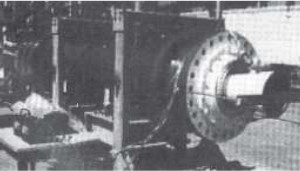Updated: 08-Oct-2020
The Marshall Space Center designed the Fastrac engine that was used on the X-34 aircraft, a NASA test vehicle.
-The engine was manufactured by Allied Signal, Thiokol and others.
-It is a rocket engine of almost 27,500 kgf of thrust using Lox/Kerosene.
-They make the ISTAR scramjet for the X-43B
They tested engines for all kinds of space flights, running on solid, liquid or hybrid fuel.
-With potential rocket applications for military use, although they prefer solid engines due to their low maintenance.
-But they did use liquid fuel on the X-33 demonstrators.
-The next one is a hybrid engine with a diameter of 24-inch giving 250,000 lbf of thrust.

"The Hybrid at Marshall Station"
Towards 1984 there was a project to repower the Shuttle with additional boosters to be able to lift higher weights -payloads-.
-It consisted of attaching some additional rockets to the normal SRBs, the standard Solid Rocket Boosters, which in turn were attached to the main tank. In the illustration below we see them in the lower parts.

“El Shuttle con mayor capacidad”
-Curiously, these small additional boosters are not common as they use solid hydrogen at room temperature as fuel. They were developed by physicists at the Carnegie Institution's Geophysical Laboratory.
From Appendix 9: NASA Marshall Space Flight Center is located in Huntsville, the FASTRAC program for hypersonic flights is being developed there.
Engines of NASA-Marshall Space Flight Center
Model: Fastrac
Arquitecture:
Chambers:
Fuels:
Feed System:
Ignition:
Thrust:
Weight:


